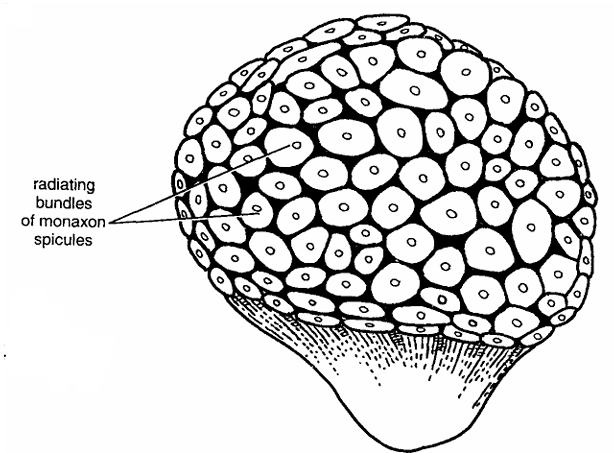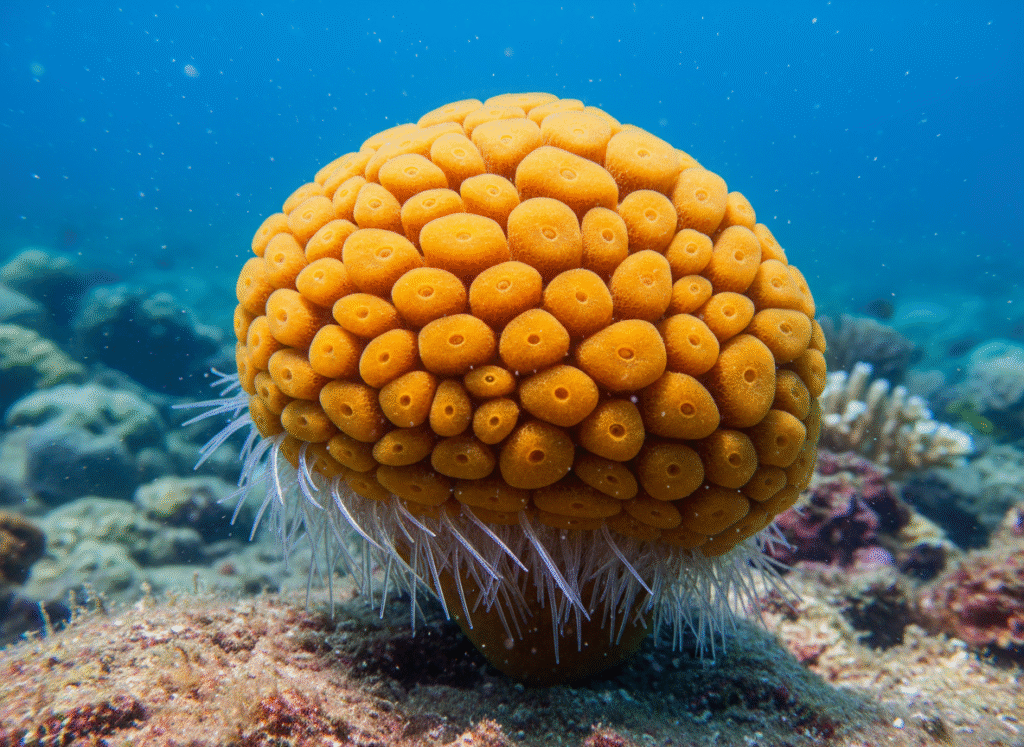Classification of Tethya
- Phylum: Porifera (Pore-bearing animals with cellular-level organization and asymmetrical to radial symmetry)
- Class: Demospongiae (Sponges with skeletons composed of spongin fibers and siliceous spicules)
- Order: Tethyida (Characterized by the distinct arrangement of euasters and megascleres)
- Family: Tethyidae (Sponges with stylote megascleres and two categories of euasters)
- Genus: Tethya
Tethya is a globally distributed genus of marine sponges well known for their spherical or hemispherical shape and distinct physical features. Belonging to the family Tethyidae, these sponges inhabit a variety of marine environments and play important roles in aquatic ecosystems.

Habit and Habitat
Tethya sponges commonly grow attached to hard substrates such as rocks, boulders, and stones. They can be found singly or in colonies, often inhabiting shallow sublittoral zones or deeper waters. Their habitats range from temperate to tropical marine environments, including coral reefs and kelp forests. These sponges can tolerate some silt but generally prefer clean waters.
Geographical Distribution
Members of this genus exhibit a near-global distribution, with a high diversity of species in Indo-Pacific tropical waters. Some species are found in temperate regions such as the coasts of Britain, Ireland, and parts of the Mediterranean. Tethya species have been reported from intertidal zones extending to depths of around 800 meters. One species, Tethya norvegica, is known in Arctic waters.
General Characteristics
- Spherical sponge attached to substratum.
- Body surface tuberculate with radiating bundles of monaxon spicules and several exasters.
- Styles have indistinct tylote ends. Spongin fibres are entirely absent.
- Tethya sponges have a spherical or hemispherical body shape, ranging up to 10 cm or more in diameter.
- The surface often exhibits tubercles or wart-like projections, sometimes with stalked buds.
- Colours vary from yellow and orange to brown and sometimes greenish shades, often depending on environmental conditions.
- An osculum is usually present and conspicuous, located opposite to the attachment point.
- The body is contractile and compressible, with a tough but flexible texture.
- The skeleton features distinctive spicular arrangements, including stylote megascleres and two types of euasters characterized by differences in size and spine morphology.
- They reproduce sexually in summer and asexually via external budding in winter.

Special Features
An intriguing feature of Tethya sponges is their ability to produce reproductive buds on short stalks atop their tubercles, enhancing dispersal. Their unique spicule morphology, especially the presence of two distinct categories of euasters, aids taxonomic classification and phylogenetic studies. Additionally, Their species are known for their role in benthic ecosystems as filter feeders and habitat providers.
Identification
The sponge has radiating bundles of monaxon spicules and all above characters hence it is Tethya.
Identification of Tethya sponges involves noting spherical or hemispherical morphology with a tuberculate surface, presence of a large osculum, and tough, compressible texture. The presence of stalked reproductive buds and color variations may help differentiate species. Microscopically, their characteristic spicule types—the presence of stylote megascleres and distinct euasters—are diagnostic.
References:
- https://www.marlin.ac.uk/species/detail/2336
- https://en.wikipedia.org/wiki/Tethya
- https://www.sealifebase.se/summary/
- https://www.marlin.ac.uk/species/detail/2150
- http://www.marinespecies.org/porifera/porifera.php?p=sourceget&id=8987
- https://www.habitas.org.uk/marinelife/species.asp?item=C2130
- https://en.wikipedia.org/wiki/Tectitethya_crypta
- https://pmc.ncbi.nlm.nih.gov/articles/PMC6460755/
- https://www.sealifebase.se/summary/
